More Fermented Fun: Cultured Butter
I promised more fermented goodies in the near future.
Specifically cultured butter.
What is cultured butter? Butter that went to finishing school and went on to get a MFA from the Chicago Art Institute?
No.
It’s butter made from cream that has either been allowed to ripen over several days without the addition of any bacterial culture, or real honest to God homemade Creme Fraiche, or cream that has been cultured with the addition of commercial cultured buttermilk.
Essentially, it’s butter made from tangy cream, not sweet cream.
In the United States, not a whole lot of folks know about cultured butter, nor do they tend to like it. It’s rather hard to find and when you can find it–its very expensive. The first time I tasted commercially available cultured butter, I popped my head up and said, “Oh, it tastes like butter at Gram’s house.”
And this is how we can tell that my Dad’s father’s family were from fairly recent European immigrant stock. It all has to do with the foods they liked to eat–many of which were unfamiliar to most American palates when Dad was growing up and when I was growing up as well.
Gram always left her butter out at room temperature. She stored it in a cupboard and in later years, the microwave, to keep bugs, dust and mischievous cats from getting into it, but it was pretty much left out to the open air. I always thought it was to keep it soft so it was spreadable, but it always had a different flavor than everyone else’s butter, and my Dad told me why.
“The Old Man,” he said, meaning his dad, my Pappa, “Liked his butter to be kind of tangy, almost rancid, just like his father and mother liked it.” Apparently, Pappa’s parents, had kitchen help who made the household’s butter by skimming cream from the milk delivery and then letting it ripen on the counter for up to three days before churning it in one of those hand-cranked glass butter churns that everyone had back in the day.
That was the way their parents, who were from Germany, made butter and to them, that was just how butter was supposed to taste.
Dad didn’t know what that was called, but it was cultured butter–which is not at all what most Americans like–we prefer “sweet cream” butter–which if you look at most any package of butter sold in grocery stores these days, they are all going to be labelled as such.
Dad said Gram’s butter tasted sort of like that, but he didn’t like any of it at all–he preferred sweet butter.
I like them both, I have to admit, with a preference leaning toward cultured butter, especially when it comes to a spread on toast or bread, or for use in sauces or on vegetables. Sweet butter is still my preferred butter for baking.
But cultured butter is SO DARNED EXPENSIVE! Usually at least twice as expensive as sweet cream butter and it’s harder to find, too.
So, do like I did and figure out how to make it on your own.
How to Make Cultured Butter
Step One: To make cultured butter, you need cultured cream, which you are not likely to find at your corner grocery. So you need to follow my directions on how to make what the French call creme fraiche which is a tastier version of sour cream. Please do not try to use commercial sour cream to make butter. It will not work. There are all kinds of stabilizers, thickeners and who knows what all in sour cream to make it artificially thick and then it is usually pasteurized nigh unto death, which is going to make it nearly impossible to use for butter making. So take the time to culture the cream your own self. Start out with the best cream you can afford–I used Snowville Creamery heavy cream that comes from pastured cows. If you live where you can get Snowville, I urge you to use it–the butter it makes is fantastic, but if you cannot get it, use the best cream you can find. (If you can get cream from a local farm or your own cow–all the better!)
Step Two:You need to churn that creme fraiche into butter.
In order to do this, you need a means by which to agitate your cream so the fat molecules bash up against each other and start clinging together into clumps that eventually become butter. (In a nutshell, that’s what happens when cream is turned into butter. Molecules bash together and stick and you get something creamy and delicious to eat on bread or cook with.)
There are lots of ways to churn butter, some of them low tech, some of them high tech and one of them no tech.
Being a frugal sort by nature, I started to use the no tech version which is to stick the creme fraiche into a glass jar so that it’s only half full, seal it up tightly, and shake the dickens out of it until you see lumps of butter separating and floating around in the thin, bluish buttermilk.
There’s a problem with this method. Two, actually. Well, there are probably more, but the reasons I gave up on it this morning are that the rough and ready agitation that is necessary for sufficiently shaking the cream such that it turns into butter makes my boobs jiggle annoyingly, and it takes forever, so my hands and wrists started to hurt.
(No, there is no video available of me shaking the jar on YouTube so do not ask.)
I refuse to wear a sports bra and wrist braces just to make butter so I put the jar down and switched to a high tech method: I used Conan, my big bronze and barbaric Kitchenaid mixer.
I skipped straight over the low tech methods, because I do not have any kind of butter churn. Nope, I do not have the Little House on the Prairie model that sits on the floor and has a churn dash attached to a pole that you plunge up and down for however long it takes to make butter sitting in the corner of my kitchen looking all pioneery and picturesque. Neither do I have one of those really neat old glass one from the early part of the 20th century that you turn a crank and a dash inside swirls around and makes butter. That’s the low tech kind I’d have, because that’s what my Grandma used to make butter when my Mom was a kid, but they are pretty expensive. Apparently people collect them and stick them on shelves in their kitchens to look all vintage and retro. I mean, I’d stick one on a shelf in my kitchen, but I’d also make butter with it too.
But I digress. Be that as it may, I used a high tech method. If you lack a Kitchenaid, you could use a hand-held mixer. Or, you could use a good heavy-duty blender. Or a really good food processor would do the trick, too. You just need something that has a part that can move very quickly through the cream and act as a churn dash, whirling and bashing and sloshing that cream together so the fat molecules start getting dizzy and grabbing onto each other for support.
If you have no low tech churn or no high tech electric device to churn your butter, I’m afraid you’ll have to deal with the boobs and wrists problem and just shake, shake, shake your jar until the butter comes. I guess you could put on a Carmen Miranda or Harry Belafonte album and dance and shake to the beat so that you get a good workout. Maybe it will burn some extra calories to make up for the butter you are making and presumably are going to eat.
Step Three: Pour your cream into your churning vessel–I used four cups of cultured cream–and start agitating. With Conan the Kitchenaid, I used the whisk attachment and started on low speed and gradually moved it up to high speed, taking great care to adjust the speed so that I didn’t slosh the cream over the lip of the bowl and all through the kitchen.
So, you agitate.
And agitate.
And agitate.
(Do you feel agitated yet? No? Well, your cream probably does.)
After a few minutes, your cream is going to come to the soft-peaks stage of whipped creamdom. That’s good, but you need to keep going. Soft peaks are when you stop the mixer and lower the bowl or lift the whisk and you end up with the cream forming a peak that goes up and then slumps over into a Dairy Queen kind of swoopdydoo.
A few minutes more, and the cream will come to the stiff peaks stage. That’s when you stop the whisk, lower the bowl or raise the whisk and your cream stands right up at attention, like a, well like something stiff. It makes a nice peak. This is where you would stop if you were making whipped cream.
But, you’re not, you’re making butter. So keep going. Soon you will come to the stage where the cream stops looking creamy and glossy and all whipped and it turns all ugly, and lumpy and curdled looking. Like this picture right here.
Kind of unappetizing looking isn’t it? This is the stage where your whipped cream has broken, and if you were trying to make whipped cream, you’d cry, tear out your hair or gnash your teeth. (It can be rescued, by the way. Just add a bit more cold liquid cream and start whisking again, first on low speed and then on to medium until it goes smooth and starts acting like whipped cream again.)
But we’re not making whipped cream, we’re making butter, so no tears are necessary. Just keep going.
And going.
And going.
The cream stays at this stage for a long time. It seems like forever. But then, you will notice little odd clumps in your curdly looking yucky cream–little granules. They’ll look something like this:
Those are wee tiny granules of butter forming, so don’t stop now, but keep going.
It will seem as if it’s taken forever for those tiny butter granules to start forming clumps, but trust me, if you turn away for a few seconds (to comment on Facebook, for instance) you will find yourself being splashed in the face with buttermilk. (That is if you are using a mixer–something self-enclosed like a real butter churn or a food processor will save you from a buttermilk bath.)
Quickly, turn the speed down if you are using a mixer, so that you do not shower your entire kitchen with buttermilk. What you will see at first is small clumps of butter clinging together with pools of buttermilk in between and yellow, lumpy cream in the center, but within just a few seconds, all that will remain in the bowl will be butter that has for the most part adhered to itself and is entangled in the wires of your whisk, with a few smaller lumps floating in a small pool of buttermilk.
Stop your churn, mixer or other mechanical device, or your arms from shaking the jar, and lift out the butter.
Step Four: (I’ll bet you never thought we’d ever get to step four.) Pull your butter out and after letting as much buttermilk drain off of it as possible for a few seconds, set it in a bowl. Fish out any smaller lumps of butter from the buttermilk and set them in the bowl as well. Then, set a fine strainer over a jar and pour the buttermilk into the jar. Rescue any butter bits that end up in the strainer, and put them with their brethren in the bowl, tightly close the lid to the jar and put the buttermilk in your fridge. This can be used for baking, and I suspect for starting another batch of creme fraiche. Some people like to drink it–my Dad liked to when he was a kid, and so did my Mom.
Step Five: Now, you must knead the butter to extract as much buttermilk as possible from it. Here’s where I went all Little House on the Prairie, and used a small wooden (well, mine was bamboo, but whatever) paddle, working the butter all around the bowl. Pushing and scooping and pushing again with the paddle, kneading releases tiny droplets of bluish white buttermilk which ooze from the mass of butter, and form puddles in the bowl. Drain these off carefully by tipping the bowl, while with one hand you keep the butter from falling into our sink.
You could do this with your hands, but your hands are warm and will begin to melt the butter. This could make your hands slippery, so when you try to tip the bowl without dropping it–well, you can imagine the tragedy that could strike. You can’t very well scrape butter out of your sink into which shards of bowl have embedded themselves and then eat that. It doesn’t have to be a paddle–it could be a wooden spoon, or I suspect a metal spoon for that matter, though a wooden one would be more comfortable to hold for the job.
Keep kneading until you can get no more buttermilk out. The more buttermilk you remove, the longer your butter will stay fresh. If you leave buttermilk inside it, your butter will go rancid, which is not the same thing as cultured, and it will smell and taste awful.
Step Six: Rinse the butter by running very cold water over it in the bowl, while kneading it with the paddle. You can run water into the bowl until it is half full, turn off the water, knead for a while, and when the water turns cloudy, dump the water out and start again with fresh cold water from the tap. Keep rinsing until the water comes out perfectly clear–as clear as it was coming from your tap. This is how you get rid of those last tiny, stubborn droplets of buttermilk. Drain the rest of the water out–which magically doesn’t carry your butter out with it because fat and cold water do not mix!
Step Seven: Next, if you want to, add a bit of salt to the butter by sprinkling very fine salt over your mass of butter and kneading it in with your paddle. Taste as you go. Salt not only helps bring out the fullness of the cultured butter’s flavor, it also acts as a preservative, helping it last longer.
Once you’ve put in as much salt as you want–go slowly and sparingly with the salt–you do not want to overdo it–you can pack the butter into a jar or roll it up into a cylinder in waxed paper and pop it into your fridge to chill and solidify.
And that, my friends, is it. That’s how you make cultured butter!
It really is simpler than this huge post would let on. I just tried to make the explanations as thorough and descriptive as possible and then put in a lot of photographs so you’d see each step of the process. This isn’t meant to make it look complicated–it’s to help build your confidence if you decide to try making your own cultured butter in your own kitchen.
You can use these instructions to make sweet cream butter–just leave out step one and start out with plain old heavy cream from the store–not ultra-pasteurized if you can manage it.
Taste your butter and enjoy it. You can use it just as you would use sweet cream butter–on bread or toast, or in cooking. It adds a wonderfully tangy, somewhat nutty flavor to any dish to which it is added and pastry made with it has a more complex flavor than that made with regular sweet cream butter.
I hope you do try making this–it’s fun to do–especially if you have kids helping–and you end up with a product that would cost you quite a bit if you bought it in the store. Four cups (one quart) of cream yields about one pound of butter, and around two cups of buttermilk. If you bought that in the store–it would be about ten dollars for the cultured butter and the buttermilk usually goes for three or four dollars a quart.
I spent about four dollars, maybe for that quart of cream, so look at how much money I saved–but the money isn’t the main point. The main point is the flavor of the butter is so much more intense, fresh and delicious than any cultured butter I’ve ever bought, and I have the satisfaction of making it in my own kitchen using ingredients I know and trust.
8 Comments
RSS feed for comments on this post.
Sorry, the comment form is closed at this time.
Powered by WordPress. Graphics by Zak Kramer.
Design update by Daniel Trout.
Entries and comments feeds.

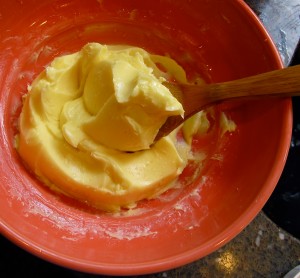
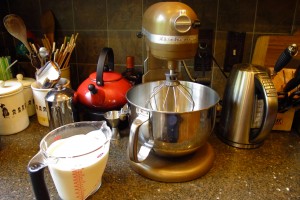
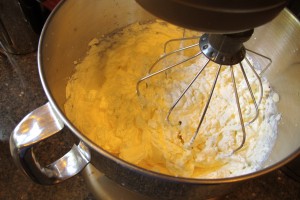
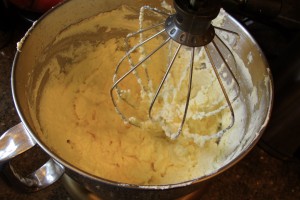
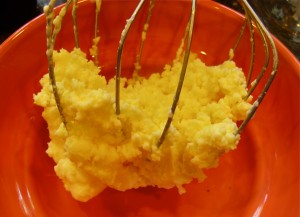
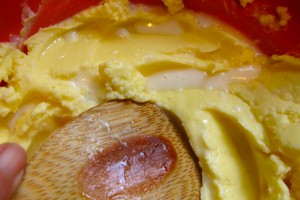
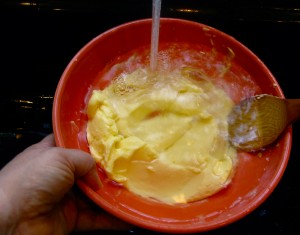


FYI, the link to directions for making creme fraiche in step 1 didn’t work for me. Otherwise, thanks for an informative post.
Comment by debby — August 23, 2012 #
While you’re on the subject of dairy, what are your thoughts on raw milk and the brouhaha surrounding it these days? I’m extremely interested in your opinion.
Comment by Jan's Sushi Bar — August 23, 2012 #
Have you ever tried Amul butter from the Indian store? It’s not like American sweet cream butter, and I suspect it might be cultured (or flavored to taste like cultured butter). In any case it’s pretty delicious!
Comment by Chai Tea Latte — August 23, 2012 #
Debby, thank you for telling me about the messed up link. There was one wee bit of code out of whack in it, but I fixed it and now it’s working.
I have never tried Amul butter–I have seen it, but not bought it, probably because I can get (and now make) such good grass-fed butter and ghee that is local I never picked it up. But I will taste it–now I’m curious to see what it’s like.
Ah, Jan, raw milk.
I am of the opinion that it should be legally available, but carefully monitored.
There is a reason we have pasteurization today–and that reason was tuberculosis. It spread through cow’s milk that hadn’t been handled well. Other disease causing bacteria can live and thrive in milk that make pasteurization not a bad thing in my opinion.
Ultra pasteurization is another thing entirely–it changes the flavor and structure of milk and in many scientists’ opinions it kills much of the nutritive value as well. (Whipping ultra pasteurized cream by hand is a test of endurance–whipping the cream I get from Snowville which is minimally pasteurized at a lower temp by hand is a breeze.)
I do think that the dairy regulations that were put into place to protect consumers are now being used as bludgeons to intimidate small producers and farmers in favor of the dairy industry, which in my opinion is producing milk and dairy products that are filled with unhealthy unnecessary hormones and antibiotics, and which are different structurally from milk produced by grass-grazed cows–different enough to render it less healthy for humans to consume.
So, my feeling about raw milk is this–it should be available, it should be legal, but it should be monitored and regulated just as any consumer food product is–with minimal regulations to ensure that only healthy products make it to market.
In other words, don’t throw the baby out with the bathwater.
Comment by Barbara — August 23, 2012 #
Maybe I should write a post about raw milk, huh?
Comment by Barbara — August 23, 2012 #
Ooh, I need to try this (and then blog about it!) My fiance loves cultured butter, but it’s even more expensive here in Canada ($7-10 for half a pound). It would be a totally reasonable price if I make it myself!
Comment by Karla — August 24, 2012 #
I have never tried cultured butter – didn’t even know it existed. Do have a kitchenaid, can make creme fraiche so I better try this out. Next time I go to Minnesota I can even get our grandmother’s old butter jar with the paddle as my brother probably has never done anything with it except dust it on occasion.
Comment by Maureen — August 25, 2012 #
Karla, get the best cream you can buy–not ultrapasteurized, and have at–it is WAY cheaper to make it yourself. And it is SO good.
Maureen–do get grandma’s glass butter churn–I am going to buy one eventually, which is a bummer because now their expensive, but I don’t want to have to rely on electricity if I don’t have to.
Do let me know how y’all’s experiments go, though. I want to hear!
Comment by Barbara — August 25, 2012 #